Letters from Lodi
An insightful and objective look at viticulture and winemaking from the Lodi
Appellation and the growers and vintners behind these crafts. Told from the
perspective of multi-award winning wine journalist, Randy Caparoso.
Revising our assumptions and classifications of wine region climates
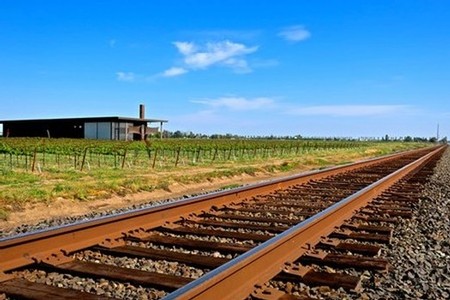
m2 Winery estate under April 2018 skies
More and more wine consumers, as well as journalists and online scribes, are starting to notice that the Lodi Viticultural Area produces light, refreshing, perfectly crisp and natural white wines without any winemaker “adjustments,” like the addition of acidity in the winery.
Lodi is also known for Zinfandel – the region crushes nearly 40% of the entire state’s production each year. With the advent of smaller, artisanal Lodi based producers over the past 10 or so years, Zinfandel lovers are starting to notice another salient fact: Lodi produces a more delicate, gentle, fragrant style of Zinfandel – in comparison to the bigger, thicker, riper, jammier styles associated with, say, Napa Valley and most of Sonoma County.
What gives?
For those who still think Lodi is a wine region as hot as the Sahara – or, maybe, the Madera Viticultural Area in Fresno County – this recent evolution seems to defy preconceptions. In one recent online report filed by well-known blogger, Lodi’s growing season temperature was described as “Region V,” making it similar to Madera (re wine-searcher.com's Too Hot to Handle). The Roman-numerical description of Lodi’s climate was in reference to the “heat summation” system originally devised by Professor A.J. Winkler of U.C. Davis during the 1940s to classify the different California wine growing regions: Region I being the coolest climate region, and Region V being the hottest.
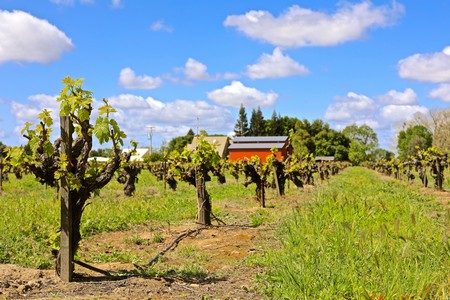
Old vine Zinfandel on Mokelumne River-Lodi's east side
To set the record straight: A growing production of white wines with natural, zesty acidity, as well as delicate Zinfandels with floral (as opposed to raisiny) aromas, would be virtually impossible in a Region V region. Ergo: Lodi is no more a "Region V" than, say, Napa Valley (which we explain below). Lodi is far from Madera both climatically and geographically. The driving distance between the cities of Lodi and Fresno is approximately 137 miles; more than twice the distance between Lodi and Napa (about 56 miles).
Thus, not coincidentally, Napa Valley is the wine region with a growing season climate most often compared to Lodi’s, as we pointed out in a blog posted three years ago (re How warm, or cool, is Lodi?), where we compared the average high (day-time) and low (night-time) temperatures of the two AVAs during the months of March through October, when grape vines are active. The figures we compiled, reflecting temperatures recorded by the Western Regional Climate Center going back over 100 years, to 1893:
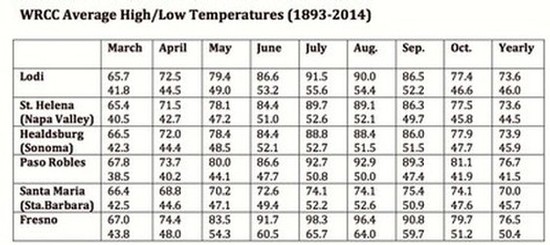
The numbers speak for themselves, but here’s the thing: Temperatures alone do not describe any wine region’s climate. There are myriad other factors affecting quality and style; such as degree or abundance of sunlight, rainfall, humidity, wind, evapotranspiration, and more (re Lodi viticulturist Stan Grant’s piece on Comparative Wine Growing Climatology).
The Winkler scale, which has become the most widely used method of classifying wine growing regions all around the world, was based upon the concept of “degree-days” – calculated by the amount that each day’s average temperature exceeds 50° Fahrenheit, between the growing season months of April and October. The reason why Winkler’s heat summation is based upon 50° F. is because at temperatures lower than this, grape vines do not effectively photosynthesize. In other words, during nights when the temperatures are hitting 49°, 45° or lower, vines become inactive.
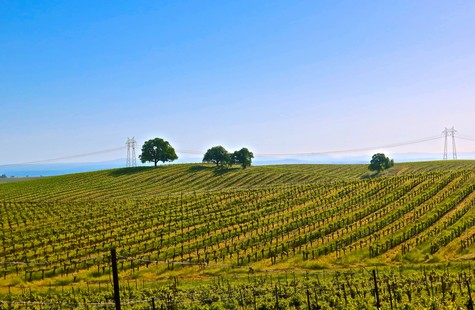
Bokisch Vineyards' Vista Luna Vineyard in Lodi's Borden Ranch AVA
Winkler’s climate classification of regions, from coldest to hottest:
• Region I (2,500 degree-days or less)
• Region II (2,501–3,000 degree-days)
• Region III (3,001–3,500 degree-days)
• Region IV (3,501–4,000 degree-days)
• Region V (more than 4,000 degree-days)
Most recently, however, a number of viticulturists have been arguing for a more accurate climate classification system entailing the true complexity of wine growing regions. The Lodi AVA (i.e. American Viticultural Area), for instance, is divided into 7 sub-AVAs; recognized more for their distinct topographies and soil types than for temperature-related differences. Napa Valley, however, consists of no less than 16 sub-AVAs; all of which are recognized as much for their wide variance of temperatures (or degree-days) as for their differences in topographies, soil types, elevations, slope, aspect, and numerous factors defining terroir.
Other California regions known for the wide temperature variations of their respective sub-appellations include Sonoma County (consisting of 17 AVAs), the Paso Robles AVA (11 sub-AVAs), and Santa Barbara County (6 AVAs). While the average consumer may not understand the impact of sub-appellation variables on what they taste in the bottle, the fact of the matter is that terroir-related factors strongly influence viticultural and winemaking decisions, thus making a huge difference in how wines turn out.
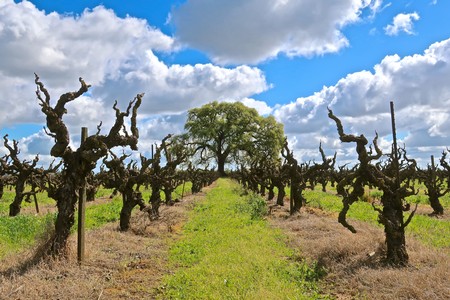
Early April light on ancient vine Carignan on Mokelumne River-Lodi's west side
Perhaps the most influential work done on the differences in climate found in American appellations was done by a Research Climatologist named Professor Gregory V. Jones, who is Director of the Center for Wine Education at Linfield College (McMinnville, OR). In his April 2015 paper entitled Spatial Analysis of Climate in Winegrape Growing Regions in the Western United States*, Jones argued for an updated overview of climate classification that entails minimum as well as maximum degree-day readings, which come a little closer to recognizing the complexities of wine regions. (*Written in collaboration with Andrew A. Duff, Andrew Hall and Joseph W. Meyers).
In his proposal, Jones based his revision of Winkler’s original system of degree-day classification on Celsius units, rather than the Fahrenheit used by Winkler, which alters the formula somewhat. Re:
• Region I (1,389 degree-days or less)
• Region II (1,390-1,667 degree-days)
• Region III (1,668-1,944 degree-days)
• Region IV (1,945-2,222 degree-days)
• Region V (more than 2,223 degree-days)
As an example of the wide variance of degree-days (shortened as GDD, i.e. Growing Degree Days) to be found in the U.S., some of the wine regions cited by Jones:

As you can see in Jones’ revised index, Napa Valley’s 43,000 or so acres of wine grapes are planted in no less than five different degree-day classifications. Its climate ranging from as cool as Region I to as warm as Region V, Napa Valley is a prime example of what Jones calls a “spatial variability.” Yet no one would describe Napa Valley as a "Region V"; especially since, as Jones notes, “the AVA reveals that it is predominantly Region III (56%) and Region IV (30%).”
Lodi, by the same token, is predominantly and consistently a Region IV; while falling in the lower range of Region V just 22% of the time; despite being easily the most widely planted wine region in the U.S. (at some 110,000 acres, more than Napa Valley and Sonoma County combined).
Jones’ research shows that Paso Robles (about 40,000 total acres) “spans three Winkler regions... Region II, III and IV (14%, 49% and 37% respectively).” On the other hand, the much warmer Madera AVA (about 38,000 acres of wine grapes) “is largely a hot climate type... a Region V in GDD (100%).” This prevailing percentage makes Madera's climate hugely different from that of Napa Valley or Lodi's.
So how do you classify the Lodi AVA? We describe it as a warm winegrowing region, very much in a Mediterranean Climate zone (i.e. warm days and cool nights throughout the growing season). It is both its consistently moderate temperatures and daily diurnal swings that allow Lodi to grow California's greatest diversity of wine grapes - from Albariño to Zweigelt, Sauvignon blanc to Cabernet Sauvignon, and over 100 others – and produce premium quality wines from every one of them. Then again, you may have already known that from what you have been tasting in the bottle!
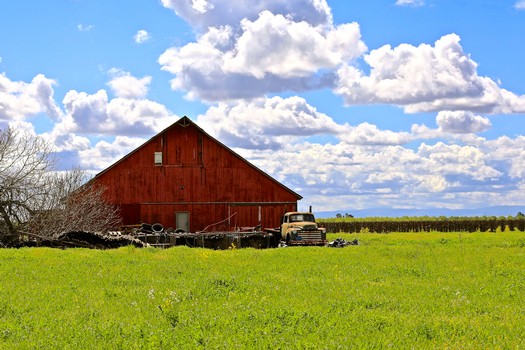
April sky over Lodi's west side